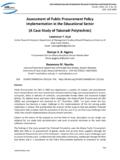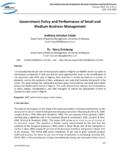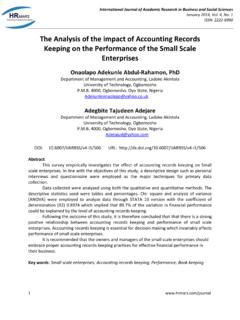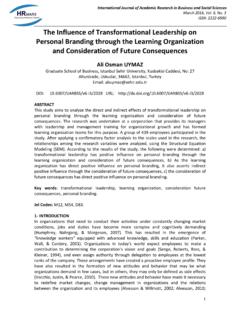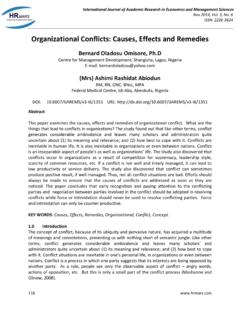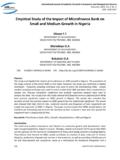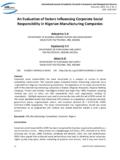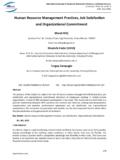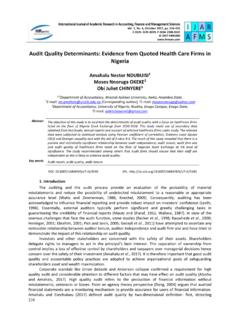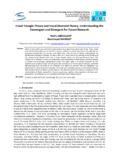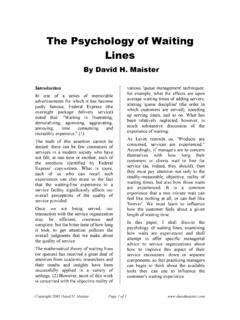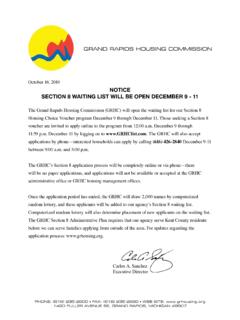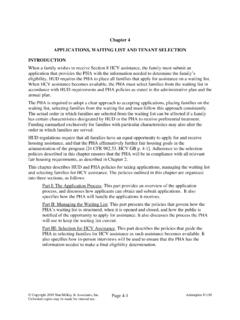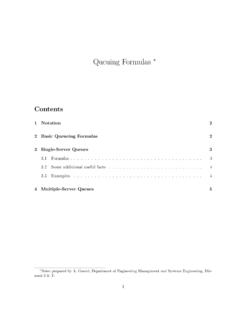Transcription of Queuing theory and the management of Waiting-time in ...
1 International Journal of Academic Research in Business and Social Sciences February 2014, Vol. 4, No. 2 ISSN: 2222-6990 34 IJARBSS Impact Factor: (Allocated by Global Impact Factor, Australia) Queuing theory and the management of Waiting-time in Hospitals: The case of Anglo Gold Ashanti Hospital in Ghana Sam Afrane College of Art and Social Science, KNUST, Kumasi Alex Appah Anglo Gold Ashanti Hospital, Obuasi DOI: URL: Abstract Queuing is a major challenge for healthcare services all over the world, but particularly so in developing countries. Application of Queuing theory to enhance decision making to improve this problem is not commonly used by managers in developing countries in contrast to their counterparts in the developed world.
2 This study investigates the application of Queuing theory and modelling to the Queuing problem at the out-patient department at AngloGold Ashanti hospital in Obuasi, Ghana. Using a descriptive, observational and ex-post facto case study approach, data was generated, analysed and used to model five capacity scenarios for the outpatient department. It is established that the optimum system performance can be achieved with eight doctors effectively at post from contrast to the prevailing five doctors that were effectively at post. In sum, the study establishes that applying Queuing theory and modelling to Queuing and capacity challenges can enhance decision making with regards to what will provide optimal performance. INTRODUCTION Queuing is a challenge for all healthcare systems.
3 In the developed world, considerable research has been done on how to improve Queuing systems in various hospital settings. This, unfortunately, has not been the case in developing countries like Ghana. This paper seeks to contribute to this subject by analysing the Queuing situation in public hospitals in Ghana and also to bring its practical value to how decision making can be enhanced in hospitals. Queuing theory is a potent mathematical approach to the analysis of waiting lines performance parameters in healthcare delivery systems (Ozcan, 2006). It has increasingly become a common management tool for decision making in the developed world. This vital tool is unfortunately minimally used in most healthcare systems in Ghana and other African countries. Review of extant literature establishes the use of Queuing theory and modelling in improving waiting time in various hospital settings (McQuarrie, 1983; Green 2006a; Siddahartan, Jones and Johnson, 1996).
4 It has also been used in reducing costs relating to various aspects of healthcare (Keller International Journal of Academic Research in Business and Social Sciences February 2014, Vol. 4, No. 2 ISSN: 2222-6990 35 IJARBSS Impact Factor: (Allocated by Global Impact Factor, Australia) and Laughhum, 1973) and generally improving system performance (Murray, 2000) in hospital systems.. Long waiting queues are symptomatic of inefficiency in hospital services. Unfortunately this is the case in many public hospitals in Ghana and other developing countries. Capacity management decisions in Ghanaian hospitals are generally based on experience and rule of the thumb rather than with the help of strategic research model-based analysis. Like many big hospitals in Ghana, AngloGold Ashanti (AGA) Hospital in Obuasi, Ghana receives a large number of patients every day and this generally results in long patient waiting times.
5 In response to this challenge, this paper analyses the Queuing system of the outpatient department of AGA Hospital in order to develop a model that can help reduce the waiting time of patients. Specifically, the paper seeks to construct a structural model (or flowchart) of patient flow within the OPD and to model a Queuing system using the Queuing theory to minimize patient waiting times in the hospital. Application of Queuing theory to model hospital settings has been widely published (Ivalis and Millard, 2003; Adele and Barry, 2005; Vasanawala and Desser, 2005). Also, the use of Queuing analysis and simulation to enhance performance at various hospital departments has been widely researched (Green, 2002), (Kim et al., 1999) and emergency departments (Green et al, 2006).
6 In most healthcare settings, unless an appointment system is in place, the queue discipline is either first-in-first-out or a set of patient classes that have different priorities (as in an emergency department, which treats patients with life-threatening injuries before others). McQuarrie (1983) showed that it is possible to minimize waiting times by giving priority to clients who require shorter service times. Green (2006a), also provide models for queue disciplines while Siddhartan and Associates (1996) analyse the effect on patient waiting times when primary care patients use the Emergency Department. They propose a priority discipline for different categories of patients and then a first-in-first-out discipline for each category.
7 Singh (2006) looked into minimizing total cost incurred and also minimizing the waiting costs by comparing the outputs for two nurses, three nurses and four nurses by evaluating the performance measures for each of the scenarios. In that study, it was found that scenario of 3 nurses was the optimal solution with optimum trade-off between the two types of cost involved in Queuing models. In another study, Obamiro (2003) also applied the Queuing theory in a study to determine the optimum number of nurses required in an antenatal clinic to reduce the time spent by pregnant women in the queue and the system. Queuing theory and modelling can thus be said to be useful modern tools for decision making on issues of capacity and resourcing. Also the number of messengers required to transport patients or specimens in a hospital by assigning costs to the messenger and to the time during which a request is in queue was determined by Gupta and Associates (1971).
8 In a Queuing network, a patient may have to go through several nodes and consequently several queues in order to obtain the desired service. Nodes where the ratio of demand to available service capacity is relatively high become bottlenecks. Such bottlenecks increase overall patient waiting times even though other nodes may have low utilization. One of the major elements in improving efficiency in the delivery of health care services is patient flow. Good patient flow means that patient Queuing is minimized International Journal of Academic Research in Business and Social Sciences February 2014, Vol. 4, No. 2 ISSN: 2222-6990 36 IJARBSS Impact Factor: (Allocated by Global Impact Factor, Australia) and poor patient flow means that patients suffer considerable Queuing delays (Hall et.)
9 Al, 2006). Effective resource allocation and capacity planning are determined by patient flow because it informs the demand for health care services (Murray, 2000). Queuing theory provides exact or approximate estimation of performance measures for such systems based upon specific probability assumptions. In a hospital, these assumptions rarely hold, and so results are approximated (Cochran & Bharti, 2006). RESEARCH METHODOLOGY The study adopts a descriptive, observational and ex post facto case study approach. In depth review of hospital OPD attendance records from January to June, 2010 was made. Interviews with management , doctors, and records staff were conducted to validate the secondary data and to gather information required to construct the structural model of the routings in and out of OPD.
10 Direct observations were used to model patient average arrival and length of stay. Questionnaires were also used to gather information on daily arrival rates, patients view on Queuing at the hospital, waiting time to consult a doctor, etc. The survey population of the study was the entire out-patients of AGA Hospital in Obuasi during the period of the study. In all, 475 patients were surveyed for this study. Purposive sampling, a non-probability sampling technique in which the researcher selects a group of people because they have particular traits that the researcher wants to study was used. The out-patient department was selected because it had the greatest Queuing challenge compared to the other units in the hospital. RESULTS The survey revealed that patients arrive at the outpatient department and drop their hospital card in a box and wait their turn.
